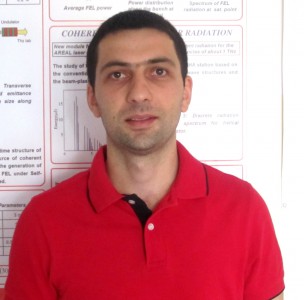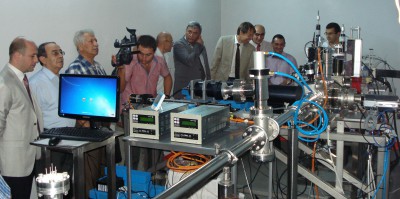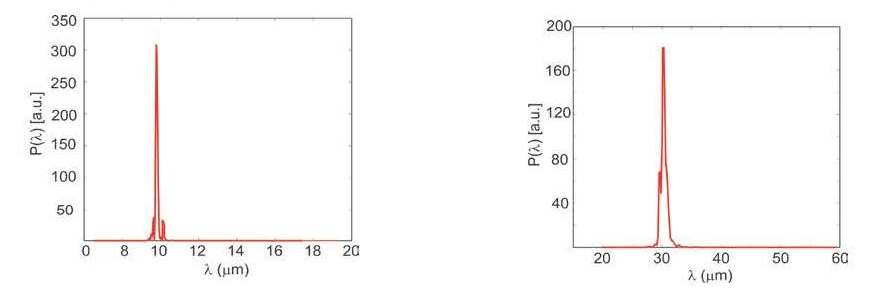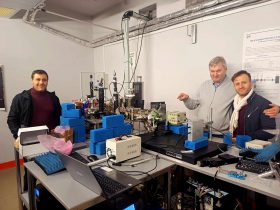 Coordinator– Dr. Vahe Sahakyan
Coordinator– Dr. Vahe Sahakyan
ALPHA – Amplified Light Pulse for High-end Applications
THz Coherent Radiation Source based on AREAL

Advanced Research Electron Accelerator Laboratory (AREAL) [1, 2] based on photo cathode RF gun is under construction at the CANDLE. The basic aim of this new facility is to generate sub-picosecond duration electron bunches with an extremely small beam emittance and energies up to 50 MeV. One of the promising directions of the facility development is the creation of ALPHA (Amplified Light Pulse for High-end Applications) experimental stations with coherent radiation source in THz region based on the concept of both conventional undulator and novel radiation sources [3].

The application of THz radiation
Terahertz (THz) radiation has attracted great attention in the past two decades. THz radiation is defined as the region of the electromagnetic spectrum which lies between 100 GHz and 10 THz. Wavelengths of radiation in the terahertz band correspondingly range from 3 mm to 30 µm.
As a new type of coherent light source, the THz radiation is of great scientific value and broad application prospects in physical chemistry, information and basic research in the field of biology, materials science, medical, national security and other technical fields [4].
Due to its unique characteristics and broad application prospects the THz wave was studied extensively. THz radiation is the electromagnetic wave, so it has all the characteristics of electromagnetic waves. THz wave has particle nature and wave nature, such as interference and diffraction. THz radiation has good penetrability on a lot of dielectric material and non-polar liquids. Therefore THz wave can be used to perspective imaging for a lot of non-transparent materials, except metals. Metal surface has almost 100 percent reflection index of the THz radiation.
Many organic molecules have strong absorption and dispersion characteristics in the THz band. The THz spectroscopy of material contains a wealth of physical and chemical information. Therefore, THz spectral imaging technology is not only able to differentiate objects morphology, but also identify the composition of them.
Since generally many biological macromolecules and DNA molecular rotation and vibration locate in the THz band level, the organisms has a unique response to THz wave; therefore, THz radiation can be used for disease diagnosis, organisms detection and imaging. Computer-aided tomography technology, which is developed and applied in the field of X-ray, is the three-dimensional imaging technique. THz wave can also be applied to computer-assisted tomography. X-ray tomographic imaging of objects can only reflect the distribution of absorption rate, while the THz tomography record the time waveform information of entire THz pulse. THz tomography can get not only the absorption rate distribution of objects, but also can get the three-dimensional distribution of the refractive index of objects and materials.
THz band has high frequency, wide bandwidth and more channel than the microwave, which is suitable for in local area networks and broadband mobile communications. 10 Gbps wireless transmission speeds can be obtained by THz communication, which is a few hundred or even thousands of times faster than current Ultra-Wideband technology. Moreover THz wave has great potential applications in the short-distance high-capacity wireless communications.
The unique nature of THz radiation brings to a broad and important application in the field of astrophysics, plasma physics and engineering, materials science and engineering, biomedical engineering, environmental science and engineering, spectroscopy and imaging technology, information science and technology, biophysics and biochemistry [4, 5].
Review of existing THz sources
Although THz radiation was first observed about one hundred years ago, this range of electromagnetic spectrum has been long considered a rather poorly explored region. This situation has changed during the past ten years with the rapid development of coherent THz sources, such as solid state oscillators, quantum cascade lasers, optically pumped solid state devices and novel free electron devices.
- Solid State Oscillators.
Electronic solid state sources, like oscillators and amplifiers, are generally limited in frequency due to the transit time of carriers through semiconductor junctions, which cause high frequency roll-off. Using such type of sources, a power of about 100 mW can be obtained around 100 GHz. To reach frequencies above 200 GHz, up to about 1 THz frequency multipliers with two or more diodes are used. The average power level achievable in the region around 400 GHz is typically in the range of 0.1 to 1 mW. The range of application of these sources is rapidly growing due to their compactness.
- Gas and Quantum Cascade Laser.
The Far Infrared (FIR) gas laser and the quantum cascade laser (QCL) are the oldest and the newest coherent source developed in the THz region, respectively. Gas lasers are optically pumped lasers, which use a CO2 laser to excite the gas molecules at pressures in the mbar range. The most widely used gas is methanol, which provides a powerful (typically 100 mW) emission line at 118 µm. Gas lasers are line-tunable in the range of 0.3 to 5 THz (1000 to 60 µm), although with limited power, and are commercially available by several companies.
The quantum cascade lasers (QCL) are the most recently invented optical lasers and have seen an impressive development in the THz region during the past few years. In a QCL electrons are injected into the periodic structure of a super lattice under electrical bias. They undergo intersubband transitions with THz photon emission excited by resonant tunneling through the multiple wells. As a result, a cascade process occurs. Historically the first QCL to operate in the THz region emitted at 4.4 THz, providing about 2mW of average power with 10% duty cycle at an operating temperature of 50 K. Recent progress in the QCL field has demonstrated that using this type of THz sources an average output power of 50 mW can be obtained.
- Laser Driven THz Emitters.
At present the laser driven THz emitters, based on frequency down-conversion from the optical region, are the most widely used sources of pulsed THz radiation. Two main techniques have been developed to produce THz radiation. The first one is based on a short pulse (femtosecond) Ti: Sapphire laser, which illuminates the gap between closely spaced electrodes on a photoconductor (e.g., silicon-on-sapphire or GaAs) generating carriers, which are afterwards accelerated by an applied bias field (100 V). The resulting current transient, which is generally coupled to a RF antenna through a stripline, radiates in a wide band at THz frequencies corresponding to the Fourier transform of the laser pulse time profile. The upper limit in frequency for these devices is given by the carrier recombination time in the semiconductor and by the bandwidth of the stripline.
A similar THz spectrum can be obtained by applying a sub-picosecond laser pulse to a crystal with large second-order susceptibility like ZnTe. Due to the nonlinear response of the crystal, photomixing occurs, producing a time-varying polarization which in its turn gives rise to THz emission. In this case higher frequencies can be reached due to the fast response of the crystal and to the absence of any stripline or conductor.
The typical frequency range covered by laser driven solid state emitters is 0.2 to 2 THz or higher depending on the laser parameters. Average power levels range from nanowatts to hundred microwatts, and pulse energies are typically in the femtojoule to nanojoule range.
- Free electron based sources.
Free electron based sources like Klystrons, Travelling Wave Tubes (TWT), Backward Wave Oscillators (BWO) and Gyrotrons have been extensively studied. The BWO is a slow wave device where the electrons spiralize through a corrugated structure in an axial magnetic field interacting with the first spatial harmonic of the backward wave. BWOs are table top devices that can operate in the THz region at moderate power levels (1 – 100 mW).
In current use most of the THz-wave sources are based on semiconductor technology or the nonlinear interaction of optical laser pulses with crystals. Critical drawbacks of these methods include the low levels of power generated (no more than 100 mW per pulse) and the lack of the tunability of optical lasers. Their operational frequencies are determined by specific molecular transitions.
To overcome these drawbacks different schemes have been developed for the generation of high power THz radiation using free electrons. The most frequently used one is the magnetic undulator originally proposed to generate mm-wave radiation.
The free-electron laser (FEL) can produce high power coherent radiation in the THz region. Also, the wavelength can be continuously tuned, the pulse length can be very short, and the intensities can be very high. These attributes make the FEL extremely attractive as a coherent THz radiation source. The appealing features of FELs (e.g. their tunability and high output power) are usually counterbalanced by some drawbacks, such as large size, high cost and system complexity. Nevertheless, most sources cannot generate THz beams with great power in the THz region, while the FEL can also meet the requirement for compactness in the THz region. Also, the technical requirements of the electron accelerator used in a FEL relax as the wavelength increases, and thus, there are a number of opportunities for cost-effective scientific applications of FELs in the far-infrared region.
An electron accelerator and an undulator are the main components of a FEL. An electron accelerator, such as a linac, can be used as a source of the ‘free’ electrons. As it is known, the accelerator can produce a beam of relativistic electrons with energies ranging from MeVs to GeVs, and peak currents ranging from hundreds of milliamps to tens of kilo-amps. Typical near-infrared FELs use beam energies of the order of 40 MeV. The beam energy for a longer wavelength machine is in the 10 to 15 MeV range. THz FELs are therefore cheaper and offer a lower technical risk than FELs operating at shorter wavelengths. Another key element of FELs is the undulator, which forces the electrons to move along curved periodical trajectories. There are two types of undulators: helical and planar. In the first case, the magnetic field vector rotates around the axis which forces the electrons to move along helical trajectories.
Several types of FELs have been built: (i) FEL amplifiers, (ii) FEL oscillators, (iii) Self-amplified Spontaneous Emission (SASE) FELs. A high-gain, single-pass FEL amplifier based on SASE is capable of producing a MW power THz pulse in an undulator of several meters in length [6-10].
THz FELs are already operating today and the vast majority of them operate in the infrared and far infrared region (i.e. THz). Several user facilities have been built to operate in the infrared region and most of them can reach or plan to extend into the THz region.
THz Free Electron Laser at AREAL
The aim of ALPHA project is the creation of coherent THz radiation experimental station using electron beam from AREAL for advanced researches in the fields of fundamental and applied sciences. The possibilities to produce THz radiation using conventional periodic magnetic system and FEL under SASE mode are under consideration.
The commissioning of the AREAL linac is divided into two stages. In current stage (phase 1), the gun section with additional diagnostics is put into operation. For phase 2 the full accelerator will be assembled.
The construction and commissioning of RF photo gun and diagnostic stations have been finished in May 2014. After successful realization of AREAL phase 1, the second phase of the project implementation being in progress implies installation of two accelerating S-band modules with corresponding diagnostic equipment and undulator section as a source of THz radiation.
The SASE FEL radiation parameters strongly depend on the parameters of electron beam and undulator line. For the SASE process strong requirements are applied for the quality of electron beam. In the linac it is required to produce electron beam with small emittance to match diffraction limited photon beam, small energy spread to avoid gain degradation and high peak current. The electron beams produced in the AREAL linac meet these criteria and can be used for the generation of THz radiation using SASE FEL principle.
In order to get the THz radiation we consider the electron beam parameters listed in Table 1. With the current design of AREAL project the energy of 20-50 MeV will be reached by two 1.5 m long S-band travelling wave accelerating sections.
Table 1. Electron Beam parameters
| Parameter | Value | Unit |
| Energy | 20-35 | MeV |
| Energy spread | 0.2 | % |
| Bunch charge | 250 | pC |
| Emittance | 0.3 | mm-mrad |
| RMS bunch duration | 2-3 | ps |
The undulator is one of the main parts of the FEL system and can be constructed from either electromagnets or permanent magnets. Attention must be paid to the field quality and alignment of the undulator. An electromagnetic (EM) undulator assisted by permanent magnets (PMs) has several advantages in terms of performance, compactness, and cost-effectiveness. It can generate field strength comparable with that of PM undulators. The field strength is changed by controlling the current, which removes the need for the complex and expensive mechanics used to change the undulator gap. In our case we consider a 5 m long undulator with period of 3 cm. The undulator specifications for our case are listed in Table 2.
Table 2. Undulator parameters
| Period length | 3 cm |
| Total length | 5 m |
| K | 2.02 |
| Peak field | 0.72 T |
The options of using planar or helical undulators are under consideration. For our parameters, the radiation wavelength is in the range of 10–30 µm that corresponds to 10-30 THz. The wavelength tuning will be performed via electron beam energy changes from 20 to 35 MeV. In case of helical undulator, if the electron beam energy varies within this range, the radiation wavelength will be 16.2- 50 µm which corresponds to 18.4 to 6 THz.
Simulation Results
To find out THz radiation main parameters (saturation length and power) GENESIS time-dependent simulations have been performed. Numerical simulations have been carried out for the case when planar undulator is used [3]. The option of helical undulator is under study.
Time-dependent simulations have been performed for the cases when radiation wavelength is 10 µm and 30 µm. In case of 30 radiation wavelength, rms bunch duration is assumed to be 3 ps with the energy of 20 MeV. For the case of 10 radiation wavelength, bunch rms duration is 2 ps and energy is 35 MeV. In Fig. 1 the average FEL power variation along the undulator line at 10 and 30 µm radiation wavelengths is shown.

Figure 1: Average FEL power at 10 (left) and 30 (right) radiation wavelengths.
For this range of parameters the FEL saturates after 3.7 m at 10 µm radiation wavelengths and after 3.4m at 30 µm wavelengths. The peak power at saturation is about 27 MW and 14 MW for the 10 µm and 30 µm, respectively. The pulse energy is about 40-60 µJ . Fig. 2 presents the power distribution along the bunch at the saturation point for considered cases.

Figure 2: Power distribution along the bunch for 10 (left) and 30 (right) wavelengths.
A single shot spectrum of the radiation for considered cases is shown in Fig. 3.

Figure 3: Spectrum of the FEL radiation at 10 (left) and 30 (right) wavelengths.
| REFERENCE |
- B.Grigoryan et. al., Advanced Research Electron Accelerator Laboratory Based On Photocathode Rf Gun, TUPC031, Proc. IPAC2011, San-Sebastian, Spain, pp. 1066-1068.
- B. Grigoryan, G. Amatuni et al., Status of Areal Rf Photogun Test Facility, Proceedings of IPAC2014, Dresden, Germany.
- V. Sahakyan, G.A. Amatuni et al., ALPHA – The THz Radiation Source based on AREAL, Proceedings of FEL2014.
- B. Zhu, Y. Chen et al., PIERS Proceedings, Beijing, China, 1166-1170, Terahertz Science and Technology and Applications.
- G.P. Gallerano et al., Proceedings of the 2004 FEL Conference, 216-221, Overview of Terahertz Radiation Sources.
- H. Eisele, Recent advances in the performance of InP Gunn devices and GaAs TUNNETT diodes for the 100-300 GHz frequency range and above, IEEE Trans. on Microwave Theory and Techniques 48 (2000) 626.
- E.L. Saldin, E.A. Schneidmiller, M.V. Yurkov, The Physics of Free Electron Lasers, Springer, Berlin, Heidelberg, 2000.
- P. Shmüser, M. Dohlus and J. Rossbach, Ultraviolet and Soft X-ray Free-Electron Lasers, Springer, Berlin, Heiderberg, 2008.
- C. Pellegrini, J. Stöhr, X-ray free-electron lasers principles, properties and applications, Nuclear Instr. and Meth., A500, 33, 2003.
- P. Shmüser, M. Dohlus and J. Rossbach, Ultraviolet and Soft X-ray Free-Electron Lasers, Springer, Berlin, Heiderberg, 2008.
- J. Blau, K. Cohn, W. B. Colson and R. Vigil, Free Electron Lasers In 2013, Proceedings of FEL2013, New York, NY, USA.









